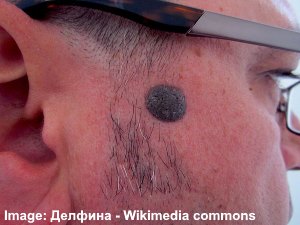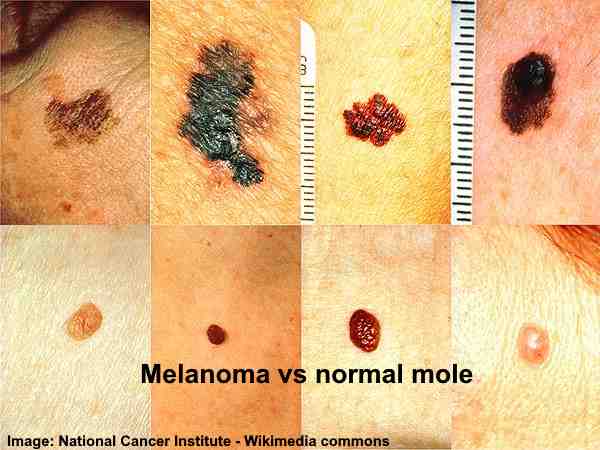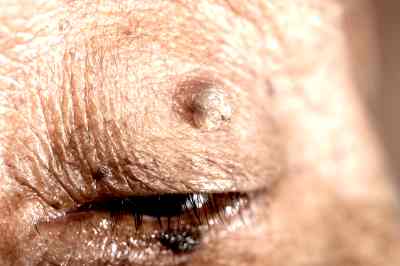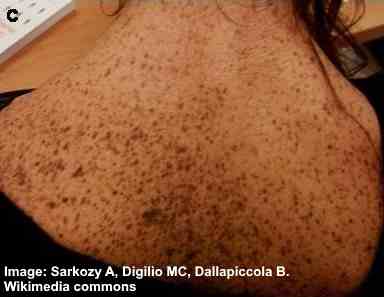Black Spots on Skin: Causes, Treatments, Pictures and More
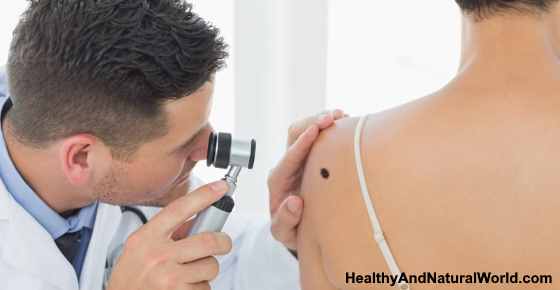
Black spots on skin can come in all shapes and sizes and can affect your face, shoulders, arms, or upper body. Some spots look like tiny black dots that resemble a black rash on your skin. Other types of black spots can be flat dark patches of skin whereas some can be raised black bumps or very dark moles.
Very often, dark patches of skin appear as we get older. This can cause dark spots on areas of the body exposed to the sun. For example, black spots on the scalp are common on older men who are bald. Some causes of tiny black dots on the face could be blackheads, scabies, or tiny dark freckles. Other reasons for dark spots on the skin can be due to some dermatological conditions. Of course, you may be worried if a black spot or mole is skin cancer.
Depending on the cause, dark spots on the skin may be itchy or irritate the surrounding area. Itching or scratching some black spots or dark skin tags on your skin may cause them to bleed easily.
Treating black spots on the face or skin usually requires addressing the underlying issue. In some cases, you should consult a dermatologist for treatment advice for black moles that appear to grow or have an irregular edge.
What Are Black Spots on Skin?
Generally, black spots on the skin can be divided into a few categories.
- Dark or black marks on the skin that are due to hyperpigmentation caused by melanin in the skin.
- Very dark skin growths that are usually harmless (like skin tags or normal moles) but can sometimes be the start of skin cancer.
- Clogged pores that turn black when the air oxidizes the sebum (oil the skin produces) plug in the pore.
Signs and Symptoms of Black Spots on Skin
Dark spots on your skin can vary in color from a dark brown color to black. Usually, very dark spots or skin patches that are caused by hyperpigmentation are dark flat patches on the skin. These kinds of flat dark spots don’t usually itch. Flat dark patches of skin are common on the face, scalp, arms, and neck.
Black skin spots could be raised itchy dark bumps that are painless. These mole-like spots can be of varying sizes and they may have the appearance of hanging off the skin. If you have acne-prone skin, you won’t just have tiny black dots on the surface of the skin, but you may have raised red pimples or pustules that are filled with pus.
Causes of Black Spots on Skin
Let’s look in more detail at the many reasons why black spots appear on your skin. In some cases, you will find effective treatments to either get rid of the black dots for good or to lessen their appearance.
Age spots (also known as liver spots or sun spots)
Age spots are small flat dark patches that appear on various parts of your skin but they are more common on sun exposed areas such as the face and the back of the hands. As their name would suggest, age spots are common in older people and look like light brown, dark brown, gray, or black patches on the skin. However, the name “liver spots” is misleading because these very dark skin patches aren’t caused by a liver disorder. Age spots are also called senile lentigo or solar lentigines.
According to the journal Experimental Dermatology, age spots are formed by melanin contained in the skin’s cells. Melanin is the pigment that gives the skin its color. Usually, excessive sun exposure over many years causes sun spots (age spots) that look like dark brown to black patches on the skin.1
Researchers from Poland also reported that other chemicals in the skin can combine with melanin to form dark patches of skin in various tones.2
Age spots can look like dark spots on the arms, dark brown patches on your cheeks and face, or black spots on the scalp or forehead.
Doctors from the Mayo Clinic say that the best way to deal with age spots is to limit sun exposure. Staying out of the sun can either help prevent dark pigmented patches of skin appearing or stop brown skin patches becoming darker or black. They recommend the following to prevent sun spots:3
- Avoid sun exposure during the late morning and early afternoon.
- Apply sunscreen with a high SPF of at least 30. Make sure the sunscreen protects from both UVA and UVB rays.
- Wear a wide-brimmed hat and keep as many parts of your body covered as possible when in direct sunlight.
Normal mole looks like a dark spot on the skin
A raised black spot on your skin could just be a dark growth that is classed as a regular mole or beauty mark. Normal dark moles can grow anywhere on your body like your face, neck, abdomen, or groin.
Dermatologist Dr. Amanda Oakely says that most people have some type of moles on their skin. Moles can be of varying colors, and red moles are not uncommon. Normal moles can also be black or brown skin growths. Some other features of normal moles can be:4
- Dark flat or raised skin spots that range in size from being a tiny black dot to many centimeters across.
- Dark brown or black bumps that can have a flat or uneven surface and may have rough edges.
- Raised dark bumps that appear in groups or clusters.
Melanoma
Many people are concerned that raised black spots on the skin could be the beginning of skin cancer.
The American Cancer Society says that although normal moles are harmless, melanoma can develop in them. Usually, melanoma looks like an existing mole that starts to change, or a new mole that develops. For example, the mole may start to show some of the following symptoms of skin cancer:5
- A mole or “strange-looking” freckle that becomes itchy or sore
- Signs that the dark patch of skin is spreading
- Redness around the mole
- The mole starts to ooze fluid, bleed easily, or look scaly
If you notice any signs of melanoma, you should see a dermatologist who will be able to distinguish between a normal mole and melanoma.
Melanoma vs. normal mole – how to tell if a mole is something to worry about
How can you know if an existing black mole or a new dark mole is something to worry about? Researchers from the National Cancer Institute use the ABCDE system to help check for signs that a mole could be cancerous. ABCDE stands for:6
- Asymmetrical. Black spots on the skin that are melanoma have two differently shaped halves that are irregular.
- Border. Black spots, moles, or large freckles that have an irregular border or blurred outline.
- Color. An uneven color is noticeable in the dark skin growth. There may be shades of black, brown, or light brown as well as other colors.
- Diameter. Most melanomas are larger than 1/4 inch (6 mm). However, it’s good to remember that normal moles can also be large.
- Evolving. The mole is changing in size or other changes are noticed.
Melanoma vs. liver spots – how to tell the difference
Melanoma can also appear as patches of darkened skin that look like liver spots (age spots). Doctors from the Mayo Clinic say that true age spots are harmless.3 However, having many age spots could put you at greater risk of skin cancer.1
You can tell the difference between age spots and melanoma by observing if the darkened patch of skin changes. Use the ABCDE system to tell the difference between melanoma and liver spots on your skin. Liver spots that become darker or change in appearance should be checked by a doctor.
Freckles look like circular dark dots
Tiny circular black dots could be freckles on your face or other areas of skin that are exposed to the sun.
According to doctors on MedicineNet, freckles are caused by deposits of melanin under the skin. This results in flat spots that can be any shade of color from yellow to dark brown to black. Lentigines are a type of freckle that cause darker than usual freckles and don’t fade in the winter.7
Usually, freckles are something you have to live with, however, avoiding over-exposure to the sun can help to reduce the appearance of dark spots on the skin. Some people use natural methods to lighten skin and help some freckles to fade.
Sun damage can cause dark patches on your skin
Damage to your skin because of the sun can result in black patches on your skin because of hyperpigmentation.
Doctors from the Mayo Clinic say that melanin pigments provide some protection from the harmful rays of the sun. However, if the skin is exposed to too much sun, dark pigmented patches of skin can appear.8
Flat black spot (or patch) on the lip
The appearance of a dark brown or black spot on your lip could be a labial lentigo that is also caused by sun damage. Dermatologist Dr. Mark Duffill says that labial melanotic macules are harmless flat dark patches on the center section of the lower lip.9
Blackheads look like tiny black dots
Tiny black dots on your nose, cheeks, or forehead could be blackheads caused by clogged hair follicles.
According to PubMed Health, the reason that the tiny plugged pores become black is due to sebum getting clogged in the pore. If the clogged pore is open and exposed to the air, the spot will turn black because of oxidization.10
Some of the best ways of getting rid of blackheads naturally include exfoliating clogged pores, or try these 12 DIY face masks for blackheads and tightening pores as well as these peel off masks for blackhead removal and deep pore cleansing.
These dark or black dots can also appear on the legs after hair removal because of a reaction in the hair follicles, and are called strawberry legs. Sometimes the dark spots that are characteristic of strawberry legs are blocked pores that become black, or an increase in the dark pigment, melanin, in the pores.
Skin tags
Skin tags are small growths that can become black spots on your skin that are harmless and aren’t painful.
According to expert in dermatology Dr. Gary W. Cole, most people get skin tags at some point in their lives. Generally, these small bumps on the skin are skin colored and can appear on the neck, eyelids, under the breasts, or in your armpits. If for some reason the blood supply to the skin tag is cut off, the skin bump will turn black and may fall off.11
There are many ways of removing skin tags safely and naturally. For example, applying apple cider vinegar or food grade hydrogen peroxide to a skin tag “burns” the skin bump painlessly. You should not use these methods to remove skin tags from your eyelids.
Dermatosis papulose nigra
Small black spots on your face or neck could be caused by a skin condition called dermatosis papulose nigra.
Dr. Mark Duffill, a dermatologist from New Zealand, says that these patches of small black papules usually affect dark-skinned people. The black spots are between 1-5 mm in size and are generally on the cheeks, forehead, upper back, or chest. There is no recommended treatment for these small black spots.12
Angiokeratomas
Small dark purple or red spots on your genitals or your upper thigh could be a skin condition called angiokeratomas.
Dermatologists say that these raised dark lesions are harmless but can bleed easily if scratched or damaged. The number of dark bumps can range from one or two to over 100. In older people, these dark spots tend to be a black or dark blue color with a scaly look to them.13
Melasma causes dark skin patches
Hormonal changes in your body can result in dark skin patches to appear on the face, temples, forehead, or upper lip called melasma.
Doctors from Harvard Medical School say that pregnant women usually develop these darkened skin patches. However, women taking oral contraceptives or postmenopausal women who take hormone replacement therapy can also develop these dark patches on the skin that don’t itch.14
Other Causes of Black Spots or Dots on Skin
Bruising. Injury to your body from a blow or falling can cause a small to large black patch under your skin. Dr. William Shiel on MedicineNet says that the black mark on your skin is a result of small blood vessels breaking under the skin. This may be accompanied by tenderness, and the bruise may change color over time before disappearing.15
Applying a cold pack as soon as possible can help to prevent a bruise from forming naturally.
Scabies. Scabies are tiny mites that can bury in your skin causing an extremely itchy red rash. Dr. Debra Jaliman on WebMD says that scabies mites look like tiny black dots on the skin. Other symptoms of scabies can be a pimple-like rash, blisters, and an intense urge to scratch.16
Natural remedies for scabies can include using tea tree oil, neem oil, or clove essential oil.
Warts from sexually transmitted diseases. Dr. on eMedicineHealth says that some warts caused by sexually transmitted diseases can have a cauliflower-like surface and look dark. These dark warts usually affect the genitals.17
LEOPARD syndrome – This is a rare genetic disorder characterized by abnormalities of the skin. People with this syndrome have multiple lentigines (black or dark brown spots on the skin), as well as abnormalities of the structure and function of the heart, the inner ear, the head and facial area, and/or the genitals.21
Tiny Black Dots on Skin
Tiny black dots can appear on your skin for a number of reasons and are generally nothing to be alarmed about. Some of the main reasons for tiny black spots on your face, hands, neck, or back can include:
- Blackheads that form in blocked sweat glands or hair follicles.
- Tiny dark moles that are just extra skin growths.
- Lentigens can appear in some people as little black dots on their skin.
- A scabies infection may look like tiny, almost microscopic, black dots on your hands, between your fingers, or around your waist.
How to Treat Black Spots on Face and Skin
Treating black spots that appear on your body generally requires addressing the underlying issue. Generally, it is very difficult to treat dark or black patches of skin that are the result of hyperpigmentation.
Dr. Elizabeth Tanzi, a dermatologist from George Washington University, says that because there are many reasons for dark spots on the skin, you should get proper advice from your dermatologist. Some chemical peels to lighten uneven skin tone can contain harsh chemicals and irritate your skin. This can even result in red patches of skin that itch and cause discomfort.18
Unfortunately, there is no quick fix for uneven skin tone, a complexion of darker patches of skin, or dark spots on your face. In cases of lighter patches of skin, using natural ingredients can help to make your skin appear lighter and more even.
For example, dermatologist Dr. Susan Evans says that lemon juice is a natural ingredient to help get rid of blotchy skin. However, you will need to regularly and patiently apply lemon juice to your dark patches on your skin to see some results.19
Some studies have shown that regularly applying aloe vera to darkened patchy skin can help to reduce melanin. This can help to reduce the symptoms of some types of hyperpigmentation.20
Of course, if blackheads or a scabies infestation is the cause of tiny black dots on your skin, then you should address these problems.
When to See a Doctor
A black spot on your skin that changes in appearance could be the sign of a serious skin condition. Doctors from the Mayo Clinic say that you should regularly check existing moles and black skin bumps for any sign of change. Also, any new mole that develops that is black, red, or pink should be assessed by a medical professional.3
When it comes to black spots on your skin, warning signs to look for are:
- A bump or mole that is black and heavily pigmented.
- A skin lesion that grows in size.
- A black raised spot that has an irregular border or show signs of spreading under the skin.
- A dark spot or pink bump that shows various colors.
- The mole or dark spot causes irritation, itching, and bleeds easily.
Read my other related articles:
- Uneven Skin Tone: Causes and Home Remedies (Research Based)
- What Causes Red Moles on Skin and How to Get Rid of Them
- Warning Signs of Melanoma, The Most Deadly Form Of Skin Cancer
Medical References

